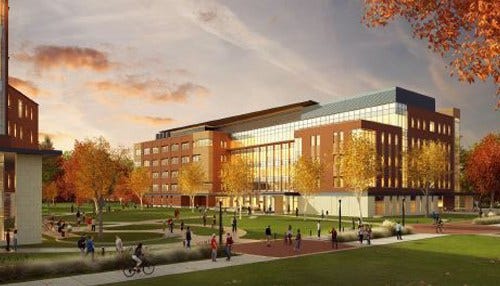Butler + Ball State = $200M Science Investment on Campus
 (Rendering courtesy of Ball State University.)
(Rendering courtesy of Ball State University.)
Subscriber Benefit
As a subscriber you can listen to articles at work, in the car, or while you work out. Subscribe NowThe training of tomorrow’s scientists is getting a nearly $200 million shot in the arm as Hoosier universities break ground on building projects aimed at undergraduate science education. Butler University is investing $100 million and Ball State University $87.5 million to build state-of-the-art science facilities. The schools have a strikingly similar story: 1960s-era buildings could no longer support the modern training demanded of today’s scientists and the booming number of students.
Butler’s College of Liberal Arts and Sciences Dean Dr. Jay Howard says “a tremendous explosion of growth in our science disciplines” prompted the university to launch the largest capital project in the school’s history: a $100 million renovation and expansion of its sciences buildings. The number of majors in Butler’s science programs has increased by 71 percent in the last 12 years.
“We’re fond of seeing ourselves as part of the brain gain solution in central Indiana; about 60 percent of our undergraduate students come to Butler from outside the state, so we’re bringing talent into the state. Among our science graduates, 63 percent currently stay in Indiana when they graduate,” says Howard. “There’s a growing need for employees in the state’s life sciences sector in particular. This is one of the ways Butler can respond to that need—by bringing fresh talent and well-prepared young scientists to work in that sector of our economy.”
Butler’s science leaders worked with Indianapolis-based companies Eli Lilly and Co., Roche Diagnostics and the former Dow AgroSciences to plan modern laboratory space that mirrors the local companies and related life sciences firms. The new labs will be highly adaptable, with adjustable designs, equipment and benches that can modify to “what teaching and learning in the sciences is going to look like in the next 50 years.”
“[The current science building] opened the same year the first pocket calculator hit the market,” laughs Howard. “The world has changed quite drastically.”
It’s the same sentiment at Ball State, where the current science facilities were designed in the 1960s.
“[The university] saw a need; modes of instruction, student participation and research have all changed considerably,” says Ball State Biology Chairperson and Professor Dr. Kemuel Badger. “[The new Foundational Sciences Building] recognizes the priority of science within the university and the needs within the state, as far as producing STEM graduates. Our graduates work in pharma, biotech and general biology, broadly.”
Much like Butler, Ball State’s sciences programs are growing, especially chemistry and biology, which have doubled the number of students in the last 15 years. Also similar to Butler, high-tech laboratories are a key focus for the $87.5 million project.
“We’re going to have a state-of-the-art facility, in which our biology and chemistry faculty participated in the design of from the beginning,” says Badger. “We’re looking at instructional needs as they are today, which are very different from what we have in [the current] building. [The new building will have] modern classrooms and collaborative learning space and involve students in hands-on research; that’s one of the key factors in development. It’s not just taking classes, it’s having the practical experience.”
Butler and Ball State leaders say the new buildings have a special focus on undergraduates—ensuring the scientists of tomorrow train in facilities that match Indiana’s high-tech life sciences sector.
“We’re excited to walk into a space that feels as energetic as the faculty, students and staff who occupy it,” says Butler College of Liberal Arts and Sciences Associate Dean Dr. LuAnne McNulty. “I think about that spark of energy that comes from being in a new space that’s built with science, growth and change in mind; I’m really excited to see how that makes a difference for our faculty and students.”
McNulty says undergraduate research is the signature teaching method for science at Butler and also gives students grit.
McNulty explains how Lilly, Roche and the former Dow AgroSciences helped shape Butler’s new laboratories.
Badger says science education has changed and is no longer simply regurgitating memorized information.
